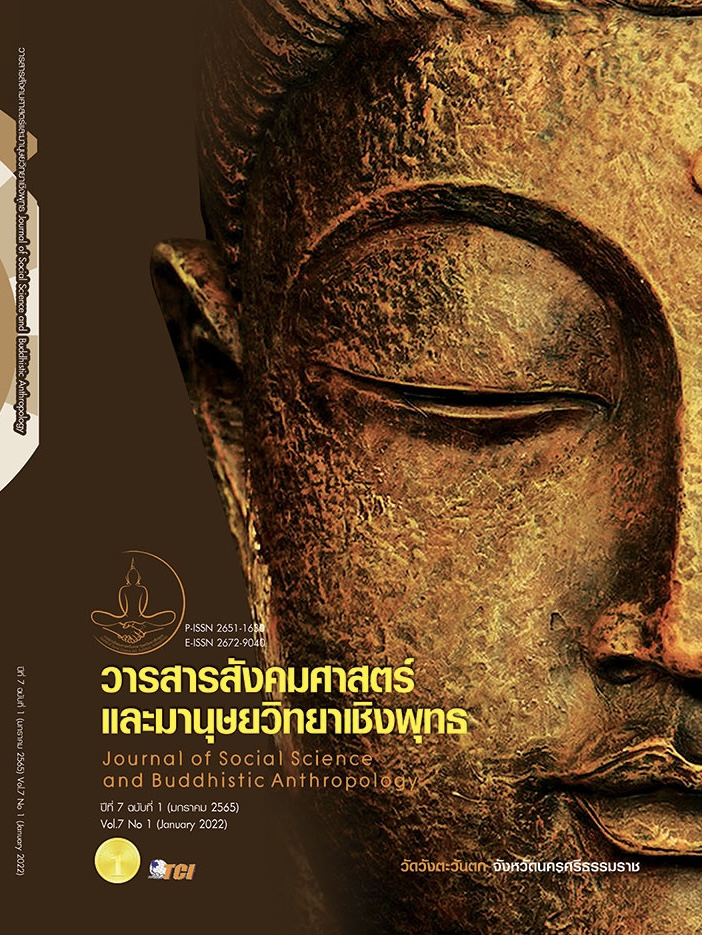PROMOTIPROMOTING ON SUSTAINABLE GREEN SPACE INCREASING IN REDUCE DUST POLLUTION FOR THE QUALITY OF PEOPLE ‘S LIFE DEVERLOPMENT IN PATHUMTHANI PROVINCENG ON SUSTAINABLE GREEN SPACE INCREASING IN REDUCE DUST POLLUTION FOR THE QUALITY OF PEOPLE ‘S LIFE DEVERLOPMENT IN PATHUMTHANI PROVINCE
Keywords:
: Promoting on Sustainable Green Space Increasing, Dust Pollution, The Quality of People ‘S LifeAbstract
The objectives of this research were to 1) study promoting on sustainable green space increasing to reduce dust pollution for the quality of people ‘s life development and 2) factor affecting promoting on sustainable green space increasing to reduce dust pollution for the quality of people ‘s life development in Pathumthani province. This research was mixed methodology research. The quantitative research was used Multi-stage sampling. The samples consisted of 400 people with descriptive statics and inferences using multiple regression analysis. The qualitative research was collected data with depth interview and focus group by 11 people. The research results revealed that: affecting promoting on sustainable green space increasing to reduce dust pollution for the quality of people ‘s life development in Pathumthani province, it found that government administrators were aware of the need to promote the increase of green space. But due to the expansion of the urban community, housing projects was reduced green space and people were less popular to use green space. It was commonly used in large department stores for leisure and economic trading. Factors affecting promoting on sustainable green space increasing to reduce dust pollution for the quality of people ‘s life development in Pathumthani province as a whole found that natural space, green space fir service and green space for community economic. The regression coefficients were 0.429, 0.512 and 0.642, respectively. The predictive coefficient was 0.892 or could predict affecting the quality of people ‘s life development in Pathumthani province as a whole was at 89.2%.
References
กัลยา วานิชย์บัญชา. (2544). หลักสถิติ. กรุงเทพมหานคร: โรงพิมพ์แห่งจุฬาลงกรณ์
มหาวิทยาลัย.
จุติชัย ด้วงลาพันธ์ และสุริยา เรียบร้อย. (2556). ศึกษาการพัฒนาพื้นที่สีเขียวภายใต้แนวคิดชุมชนนิเวศ กรณีศึกษาเทศบาลเมืองแม่โจ้ อำเภอสันทราย จังหวัดเชียงใหม่ . กรุงเทพมหานคร: คลังความรู้ดิจิตอล.
ชรัยย์รัชฏ์ บวรวัฒนะ. (2558). แนวทางการออกแบบและจัดการพื้นที่สีเขียวภายในมหาวิทยาลัยพายัพ. ใน วิทยานิพนธ์วิทยาศาสตรมหาบัณฑิต สาขาวิชาการออกแบบและ
วางแผนสิ่งแวดล้อม. มหาวิทยาลัยแม่โจ้.
ชูศรี วงศ์รัตนะ. (2544). เทคนิคการใช้สถิติเพื่อการวิจัย. กรุงเทพมหานคร: เทพเนรมิตรการพิมพ์.
ธนพร สีนาคล้วน. (2560). การประเมินศักยภาพการเป็นพื้นที่สาธารณะสีเขียวในพื้นที่เขตพระนครเขตป้อมปราบศัตรูพ่ายและเขตสัมพันธ์วงศ์. ใน วิทยานิพนธ์สถาปัตยกรรมศาสตร์มหาบัณฑิตศิลปากร. มหาวิทยาลัยศิลปากร.
ประกาศ กระทรวงอุตสาหกรรม พ.ศ. 2547. (2547). เรื่อง กำหนดค่าปริมาณสารเจือปนในอากาศที่ระบายออกจาก โรงงานผลิต ส่งหรือจำหน่ายพลังงานไฟฟ้า. ราชกิจจานุเบกษา เล่ม 123 ตอนพิเศษ 125 ง หน้า 18-20 (15 มกราคม 2553).
ประกาศกระทรวงทรัพยากรธรรมชาติและสงแวดล้อม. (2553). เรื่อง กำหนดมาตรฐาน ควบคุมการปล่อยทิ้งอากาศเสียจากโรงไฟฟ้าใหม่ราชกิจจานุเบกษา เล่ม 127 ตอนพิเศษ 7 ง หน้า7-11 (7 ธันวาคม 2549) .
ผู้จัดการออนไลน์. (2562). พื้นที่สีเขียวในเขตเมืองของไทย มีมากพอหรือยัง. เรียกใช้เมื่อ 30 เมษายน 2562 จาก https://mgronline.com
มหาวิทยาลัยเกษตรศาสตร์, คณะวนศาสตร์, ศูนย์วิจัยป่าไม้. (2558). โครงการศึกษาการท่องเที่ยวเพื่อการศึกษาระบบนิเวศ. กรุงเทพมหานคร: สำนักพิมพ์มหาวิทยาลัยเกษตรศาสตร์.
วิเชียร เกตุสิงห์. (2541). การวิจัยเชิงปฏิบัติ. กรุงเทพมหานคร: ไทยวัฒนาพานิช.
สมาคมเพื่อนชุมชน. (2561). พื้นที่สีเขียวมีประโยชน์อย่างไร. เรียกใช้เมื่อ 5 มิถุนายน 2561 จาก https://www.community.or.th/knowledge/
สุนีย์ มัลลิกะมาลย์ และ พราวพรรณราย มัลลิกะมาลย์. (2560). แนวทางการส่งเสริมการมีส่วนร่วมของประชาชนในการเพิ่มพื้นที่สีเขียวในชุมชนเมืองเพื่อลดภาวะโลกร้อน. เรียกใช้เมื่อ 19 เมษายน 2560 จาก http: //rc.nida.ac.th
สุวิมล ติรกานันท์. (2543). การประเมินโครงการ: แนวทางสู่การปฏิบัติ/สุวิมล ติรกานันท์. กรุงเทพมหานคร: โรงพิมพ์แห่งจุฬาลงกรณ์มหาวิทยาลัย.
Bryman, A. (2001). Social Research Methods. Oxford UK: Oxford University Press.
Steven, D. E. (2006). The leveraging effects of knowledge management concepts in the deployment of Six Sigma in a health care company. In Doctor of Philosophy Dissertation. Walden University.
Yamane, Taro. (1973). Statistics: An Introduction Analysis 3rd ed. New York: Harper& Rows Publishers.
Bryman, A. (2001). Social Research Methods. Oxford UK: Oxford University
Press.
Steven, D. E. (2006). The leveraging effects of knowledge management concepts in the deployment of Six Sigma in a health care company. In Doctor of Philosophy Dissertation. Walden University.
Yamane, Taro. (1973). Statistics: An Introduction Analysis 3rd ed. New York: Harper& Rows Publishers.
Downloads
Published
How to Cite
Issue
Section
License
Copyright (c) 2022 Journal of Social Science and Buddhistic Anthropology

This work is licensed under a Creative Commons Attribution-NonCommercial-NoDerivatives 4.0 International License.








